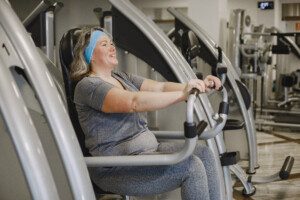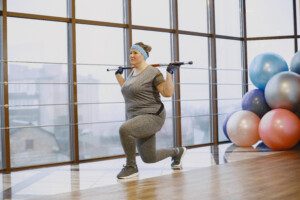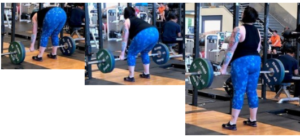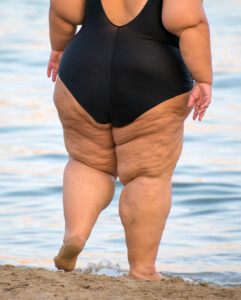Not every morbidly obese person “belongs in the pool” or “should be swimming,” as some weight loss coaches insist.
Swimming isn’t the magic bullet for weight loss in all severely overweight people.
Yet there are weight loss coaches who believe that their morbidly obese clients need to swim — as their primary workout mode — because exercise on dry land is risky to their bodies.
It goes without saying that caloric intake is the biggest issue, but the best fat loss approach also includes a daily exercise regimen.
Message to those whose line of work involves helping morbidly obese clients lose weight: Stop telling them “You should be in the pool.”
One YouTuber weight loss coach has repeatedly recommended that a particular morbidly obese influencer who has a massive online following should “be in the pool two hours a day.”
This article does NOT apply to severely obese individuals who have difficulty with basic mobility.
It applies strictly to those who, despite their size, have enough mobility to walk for exercise, and do not have any diagnosis of a disabling knee arthritis or other incapaciting issue.
The aforementioned influencer, for instance, probably weighs around 350 at 5’9 — yet is mobile enough to walk all day at Disneyland, frequently travel, go on hikes and do brief dance moves. She also trains with weights.
Though she engages in exercises, such as jumping, that put her knees at high risk for damage, she should not confine all of her exercise to the water, as the YouTuber and many of his followers believe.
However, she certainly needs to avoid the jumping, pushups, lunges, off-kilter squats and attempts at jogging, due to her significant level of obesity.
Swimming is the magic elixir for very fat people?
Swimming is often hailed as a versatile and effective exercise for weight loss due to its low impact nature, ease on the joints and ability to engage multiple muscle groups simultaneously.
However, for individuals grappling with obesity, the decision to incorporate swimming into their weight loss regimen requires careful consideration of various physiological, psychological and practical factors.
Don’t get me wrong: For some obese men and women, swimming has helped them lose a lot of weight.
I knew a woman in college who had lost 70 pounds after she began swimming. She was still overweight, though, but strong from also doing strength training.
Physiological Considerations
Caloric Expenditure. Swimming is renowned for its capacity to burn calories, with estimates suggesting that an hour of moderate swimming can expend between 400 to 600 calories.
However, the actual calorie burn varies depending on factors such as swimming technique, intensity and individual metabolic rate.
Plus, an hour of swimming is literally that: swimming laps for an hour, rather than just bobbing and splashing around for that time.
Muscle Engagement and Metabolism. While swimming engages a multitude of muscle groups, it primarily targets the upper body and core.
This emphasis on specific muscle groups may not effectively stimulate overall muscle growth, particularly in the lower body.
Those weight loss coaches seem to be forgetting that the king fuel burners in the body are the quadriceps, hamstrings and gluteus maximus — big force production muscles that require more energy for workout recovery than do the back, chest, shoulders and arms.
Since muscle mass contributes to basal metabolic rate, weightlifting exercises that promote muscle development, such as compound strength training (e.g., deadlift, barbell squat, leg press, plus bench press, other chest pressing movements, pulling motions, overhead press), will offer greater long-term benefits for weight loss in morbidly obese people.
Buoyancy and Resistance. The buoyancy of water reduces stress on joints, making swimming an attractive option for individuals with joint pain or mobility issues.
However, the resistance provided by water can also impede movement, necessitating more effort to propel the body forward.
This resistance factor can pose challenges for individuals carrying a lot of excess body weight, potentially limiting the duration and intensity of swimming workouts.
Psychological Considerations
Body Image and Self-Esteem. Obese individuals often contend with negative body image, which can be exacerbated in environments where their bodies feel exposed.
Bearing a lot of skin in a swimsuit could be quite unnerving to some very overweight people, to the point of creating a distraction from getting in their best swim workout.
And just a reminder: I’m talking swimming laps, not prancing around waving Styrofoam tubing.
Skill Acquisition and Confidence. Proficiency in swimming demands time, patience and guidance.
For significantly overweight people who may have limited exposure to swimming or negative prior experiences, the initial learning curve can be intimidating.
Building confidence and competence in swimming necessitates access to quality instruction.
You might be thinking, “Well, such an individual will probably feel just as intimidated or self-conscious on the gym floor doing strength training.”
However, there are two key elements here. First, they can conceal a lot of their body with clothing.
Second, there are plenty of weightlifting exercises for which obesity would not be an impediment. Thus, self-consciousness about performance would be greatly reduced.
Practical Considerations
Morbidly obese women and men may find it challenging to sustain high-intensity swimming sessions due to reduced cardiovascular fitness and increased exertion.
You might be thinking, “Well, they can build up to that level, just like they can build up to an hour of nonstop walking.”
But let’s not forget that walking comes naturally to the human body.
Swimming does not come naturally to many individuals — even slim athletic ones — despite those athletes who can swim in open water all day long or who can smash through the length of an Olympic size pool in under 25 seconds.
For many, the motion of even the basic freestyle is exceedingly awkward.
So to expect everyone who weighs 350 pounds to do sustained lap swimming for an hour, day after day, is totally unrealistic.
Accessibility and Availability. Access to swimming facilities varies based on geographical location and socioeconomic status.
Limited availability or affordability of swimming pools can pose significant barriers to regular participation in swimming-based weight loss regimens.
Though it seems that most apartment complexes have a swimming pool, come on, let’s face it: Using it for an hour a day for weight-loss based exercise is very impractical.
Not only are these pools often filled with families playing, but they’re open only three or four months out of the year, depending on location.
Final Notes
Weight loss coaches need to stop preaching that very fat people “need to get in the water” or “spend at least an hour a day in a pool.”
As you’ve just read, this advice has more lumps than cottage cheese.
What, then, should morbidly obese women and men do as their primary exercise as part of their weight loss regimen?

GOOD! Pexels/Gustavo Fring

NOT GOOD! Pexels/Gustavo Fring
Unless their doctor has warned against it, walking is a great start. Low impact aerobic classes may also be an option. Same with cardio machines that you pedal.
But the most effective form of exercise for very overweight people, including those who are classed as morbidly obese, is that of strength training.
The wonderful thing about lifting weights is that it doesn’t involve impact, erratic or jarring motions, and many movements can be done while seated.

Obesity doesn’t automatically disqualify one from doing the deadlift exercise. However, perfect form is crucial.

The floor leg press is safe for obese people who do not have spinal pathology. Shutterstock/Aleksey Boyko
Though obesity may make certain weightlifting exercises difficult, simply due to the excess fat on one’s body, there’s plenty of multi-joint (compound) movements from which to choose.
Swimming can be done as a cool-down following an hour of strength training.
Swimming can also be done on non-weight days.
If a morbidly obese person is drawn to the idea of getting in the water, then by all means, they should do so.
If they want to learn proper swim technique with the goal of doing lap after lap, and prefer this idea over walking or pedaling, that’s perfectly fine too.
But … swimming should NOT be a replacement for strength training!
Yet this is what some weight loss coaches preach.
Morbidly obese men and women can learn to safely lift weights, especially with machines.
The more lean muscle mass you have in your body, the faster your resting metabolic rate will be.
Lifting weights (barbells, dumbbells, kettlebells, weight plate equipment, weight stack equipment) is superior to swimming as far as building lean muscle.
Though highly competitive swimmers appear to be built from head to toe with solid muscle, remember: They train for hours every day to be as fast as possible for their specialty distances, and they also train with weights!
 Lorra Garrick is a former personal trainer certified by the American Council on Exercise. At Bally Total Fitness, where she was also a group fitness instructor, she trained clients of all ages for fat loss, muscle building, fitness and improved health.
Lorra Garrick is a former personal trainer certified by the American Council on Exercise. At Bally Total Fitness, where she was also a group fitness instructor, she trained clients of all ages for fat loss, muscle building, fitness and improved health.
.









































